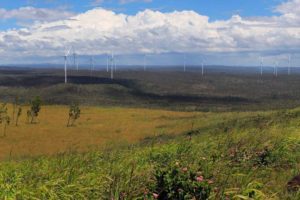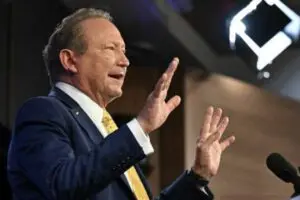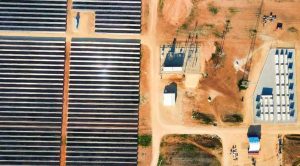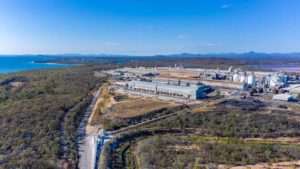When iron ore billionaire Andrew Forrest declared last year that his newly formed Fortescue Future Industries had set a target of producing 15 million tonnes of green hydrogen a year by 2030, most people thought “what a great ambition”, but wondered how and if it could be done.
It seems as though that sort of thinking was happening within Fortescue itself. But now, 12 months later and after a head spinning series of announcements, MOUs, company takeovers and claimed technology breakthroughs, they are convinced it can actually be done, and is not as far-fetched as thought.
In an interview for the latest episode of RenewEconomy’s weekly Energy Insiders podcast, FFI chief executive Julie Shuttleworth says technology advances and a surge in demand has convinced the company that it is very achievable.
“When we set this goal about 12 months ago … it certainly was a stretch target,” Shuttleworth said.
“It was very stretch, but 12 months have since passed, (there) is a huge amount of demand for green hydrogen and we’ve advanced our projects here in Australia and around the world.
“We’ve advanced our technology portfolio with advanced manufacturing, we’ve got some excellent team members … and now this is looking very achievable. It is absolutely possible but it still needs a massive effort. Of course, no one has done this at this scale before.”
To put the scale of the target in perspective, only around one million tonnes of green hydrogen is being produced in the whole world today. And Fortescue’s target would likely to require some 200 gigawatts of new wind and solar to reach that target, a bit less if it’s delivered in the form of green ammonia.
If the target is reached, it will not be an isolated achievement. It will be accompanied by a wholesale transformation of the energy and manufacturing industries beyond what most people can imagine. And it will accelerate the transition to renewables in the main grids of Australia, and other places in the world.
The ANU recently completed a study which talks of extraordinary numbers in the country’s green energy opportunities, at a scale of 27 times the current electricity production in Australia.
“When we talk about 15 million tonnes, we’ve got a portfolio of projects in Australia and around the world,” Shuttleworth says.
“We haven’t announced all of them, of course, all the ones that our teams are working on. They’re in various stages of study and resource acquisition, and advancing to make that 15 million tonnes per year by 2030.”
But while many of the Fortescue announcements are still at the “MoU” stage, and Shuttleworth says there are a lot more that we don’t know about, there have been some tangible advances.
Fortescue has bought into Dutch firm HyEt, an Australian hydrogen technology firm called Sparc Hydrogen, and the Williams Engineering team, with whom it is looking at transport options for its fleet of huge mining vehicles, and the “infinity train”, which will be powered by a regenerating battery.
It has also created a joint venture with the US-based Plug Power and is now building a factory in Queensland that will deliver 2,000MW of electrolysers a year, double the world’s current capacity.
The green manufacturing hub is likely to expand significantly – in terms of electrolyser capacity, but also in making other components essential for a green hydrogen economy, such as solar panels, wind towers, battery storage, cabling, and other materials.
“It will be a world leading hub for manufacturing electrolyzers,” Shuttleworth says. “We’re going to start with a two gigawatt per year capacity, and we … will expand it beyond there.
“We have started construction of that facility already and we expect to be making electrolysers by next year. So of course, our FFI projects alone will be strong consumer of those electrolyzers.
“We just can’t wait for the rest of the world to make electrolyzers we need to keep advancing these projects. And clearly manufacturing of the key components is a big important part of that.”
To go with this, there are a myriad different generation projects on a grand scale, some to be developed by Fortescue itself, such as the 5.4GW wind and solar, plus battery, project in the Pilbara, and some by Forrest’s private companies, such as the massive Sun Cable solar and battery project in the Northern territory, and the newly announced wind and solar hub built around a 2GWh battery in Queensland.
Fortescue has also hired the deputy governor of the Reserve Bank of Australia, Guy Debelle, to be its chief financial officer. It is the sort of big name hiring that appears to have convinced many more in the business world to take Fortescue’s green energy ambitions seriously.
Shuttleworth says Debelle, often considered a likely candidate to be the next RBA governor, had not been actively looking for a change, but agreed to move after Fortescue reached out to him.
“Guy brings huge economic credibility,” Shuttleworth says. “He’s very passionate about driving climate change and rolling up his sleeves and getting stuck into it.
“He’ll be able to help drive the most optimal financial solutions for these huge projects, development projects, and our our vast technology portfolio, it’s going to be very exciting to have Guy join the team.”
You can hear the interview with Julie Shuttleworth in full here.
And you can also download recent podcast interviews with the likes or tech billionaire Mike Cannon-Brookes, Origin CEO Frank Calabria, Victoria energy minister Lily D’Ambrosio, EnergyAustralia boss Mark Collette, Jet Charge CEO Tim Washington, and Snowy Hydro’s Gordon Wymer, please click here.
n’s big shift from baseload










